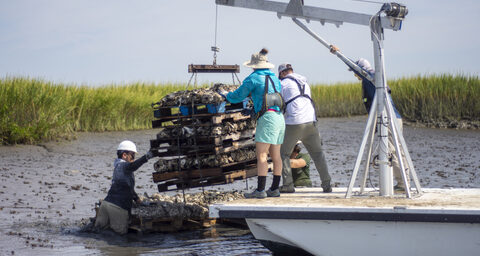Yamaha Rightwaters, Georgia Southern University launch new conservation initiative

Yamaha Rightwaters announced it has joined forces with Georgia Southern University’s (GSU) College of Science and Mathematics and the Georgia Department of Natural Resources Coastal Resources Division to initiate a new conservation project designed to restore degraded oyster beds on the Georgia coast. The research gathered during the project will help determine the carbon burial potential of newly formed oyster reefs off the coast of Georgia.
Coastal ecosystems provide the highest economic value of all naturally occurring marine systems due to biogenic habitats that perform multiple functions. Eastern oysters, Crassostrea virginica, are a commercially important species that also play a critical role in habitat creation by forming large reef structures. Through the project, approximately six tons of bagged oyster shell stacked on pallets are placed at two locations on a northern bank of the North Newport River west of St. Catherines Island to encourage the growth of new, native Eastern oysters.
“In 2022, we teamed up with Texas A&M University’s Harte Research Institute and the Coastal Conservation Association to initiate a similar conservation project designed to evaluate the role of oyster reefs in capturing and storing carbon in St. Charles Bay in the Gulf of Mexico. This new project in coastal Georgia allows us to do the same thing in the Atlantic,” said Martin Peters, director of External Affairs for Yamaha U.S. Marine Business Unit. “It’s our hope that the data collected through the two initiatives will give us more information about the carbon sequestration value of oyster reefs. The data will allow us to evaluate the possibility of increasing the scale of these programs to achieve a measurable result.”
There is currently little research about the role oyster reefs play in carbon sequestration along the coastline. Because the Georgia coastline is unique with large tidal amplitude, high energetics and large riverine inputs, research from other locations does not easily translate to Georgia management plans. Georgia-specific data collected from newly established oyster reefs is necessary to fully evaluate carbon sequestration potential.
“Not only do established reefs provide important habitat for several kinds of sea life, they also reduce carbon dioxide and, in turn, reduce ocean acidification,” said John Carroll, Associate Professor of Biology, Georgia Southern University. “The research from this Yamaha Rightwaters-supported project will provide us with Georgia-specific data that will ultimately help us determine the carbon burial potential of newly formed oyster reefs in Georgia.”
“Oyster restoration is a critical component of protecting and restoring Georgia’s coastal ecosystems,” said Paul Medders, Habitat Enhancement and Restoration Unit lead for the Georgia Department of Natural Resources Coastal Resources Division. “This project will help to reestablish oyster reefs in the North Newport River, which will benefit both wildlife and people.”




